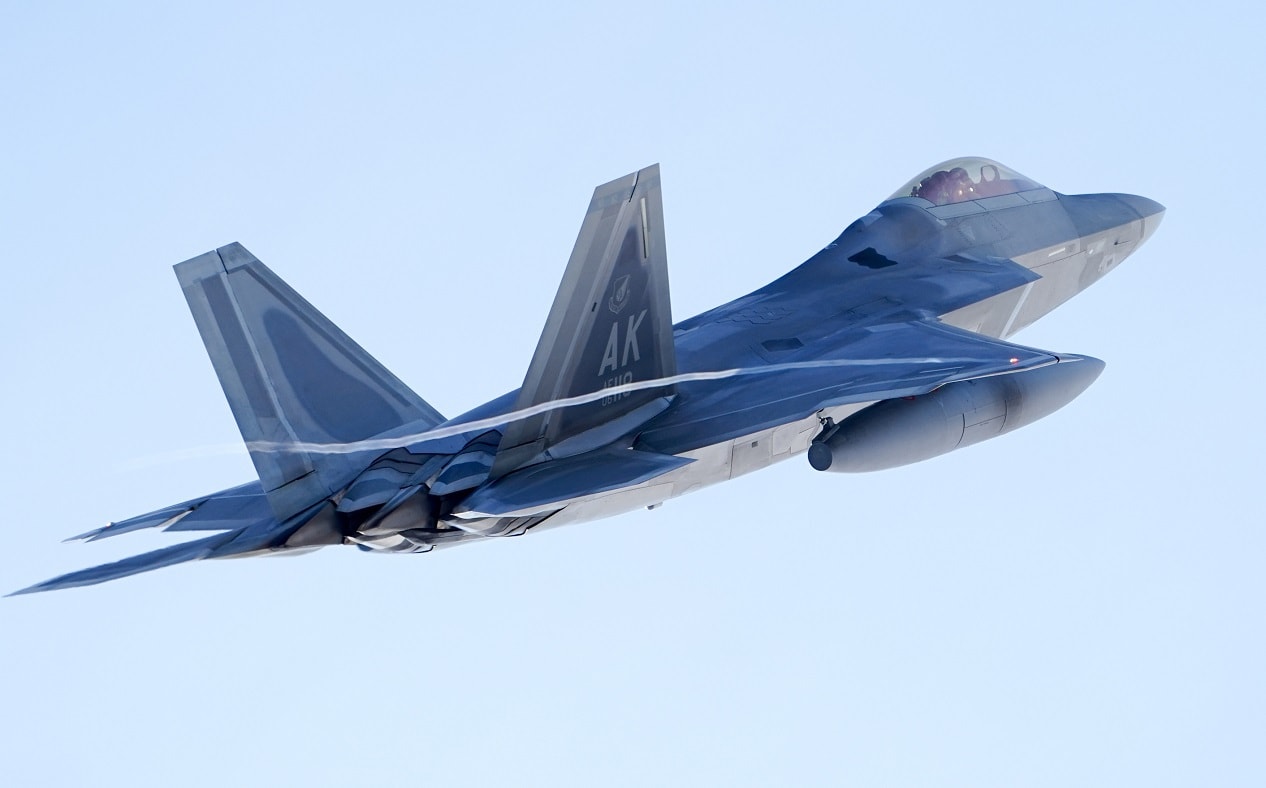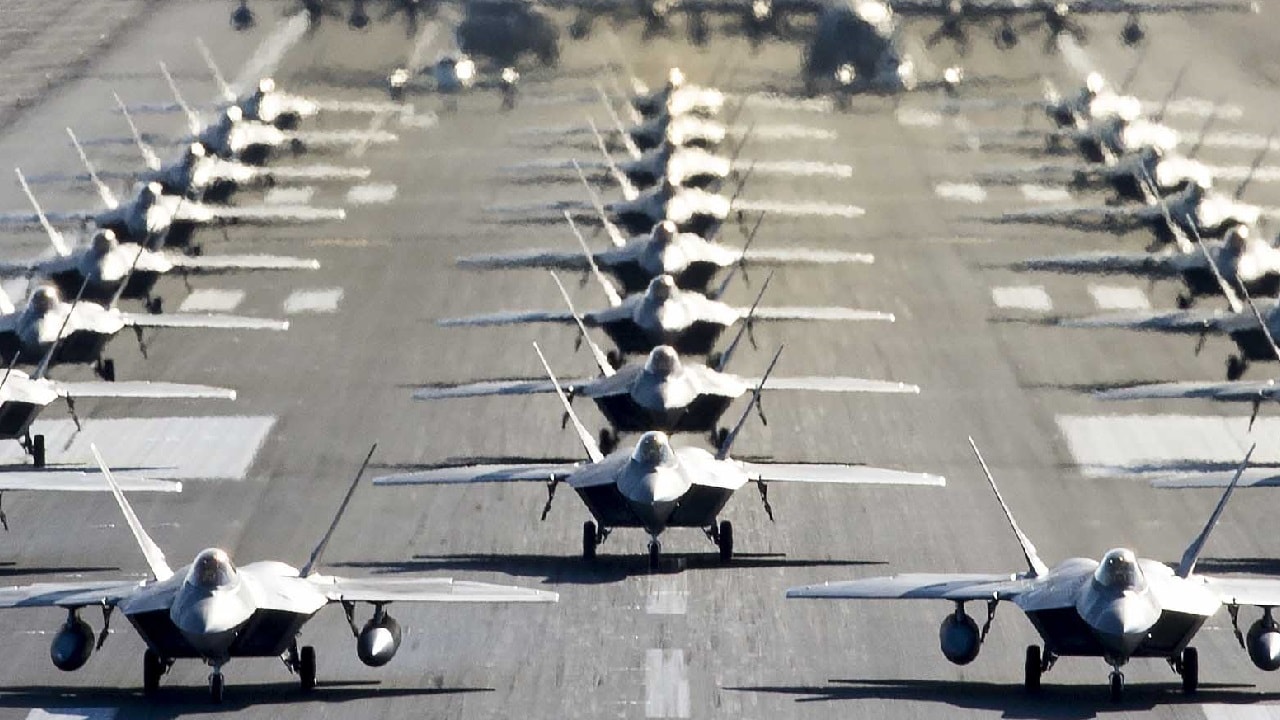Key Points and Summary: The F-22 Raptor is getting a serious upgrade, making it deadlier than ever. Improved software enhances missile targeting, while upgraded Pratt & Whitney F119 engines boost speed, agility, and maneuverability.
-The fighter’s advanced cockpit and optimized data stream provide pilots with superior situational awareness, ensuring air dominance.
-As the U.S. Air Force evaluates the costly NGAD program, the F-22 will remain America’s premier air superiority fighter for at least another decade.
-With China advancing its stealth jet capabilities, the Raptor’s continued modernization is crucial for maintaining U.S. air superiority in the Indo-Pacific and beyond.
Improvements to the F-22 Raptor Program Make It a Powerful Warbird
Sometimes, the F-35 Lightning II exploits and the up-and-down history of the Joint Strike Fighter program overshadows the F-22 Raptor.
However, some military analysts and pilots believe the Raptor is the number one fighter in the fleet.
Now, the F-22 is improving with improved software, a cockpit that creates a high of situational awareness for pilots, and an optimized data stream that allows the aviators to engage the enemy with missiles better.
Don’t forget about more powerful engine performance. The F-22 is about air dominance, and these new updates deserve a closer look.
Optimizing Missile Performance
The F-22 features essential modifications to how the airplane fires the AIM-120 AMRAAM missile.
This is the Raptor’s main armament, and now pilots will see better performances from the munition in range and targeting.
When the Raptor launches an AMRAAM it can immediately make evasive maneuvers while the missile flies on its path to destroy an enemy airplane.
Find, Fix, and Kill
The U.S. Air Force’s F3R (Form, Fit, Function Refresh) program will make the Raptor much more deadly and lethal.
With F3R, the munitions on the F-22 can be a force multiplier for better range and control.
John “Clyde” Thayer is a 22-year U.S. Air Force officer and former F-15C pilot serving as director of Air Dominance Requirements & Capabilities for Raytheon.
“We know the missile flies a lot farther than it was originally designed to. The F3R improvements – perfectly fitted to the F-22 platform – will help us get the most out of the AMRAAM missile in the air dominance role,” Thayer said in a corporate news release.
Raytheon, a division of RTX, is building 1,200 AMRAAM missiles each year. F-22s also employ Sidewinder air-to-air missiles for closer-range dogfighting.
Engines Keep Getting Better
Meanwhile, Pratt & Whitney continues to update the two F119 engines that have 35,000 pounds of thrust.
Over the years, the engine makers have collected much flight data from the F-22. This information stream has been used to update the software that controls the engine parameters.
This results in greater power and agility for more incredible speed and climb rate.
The engines are more responsive to changes in direction, which results in optimal maneuverability for dog fighting.
The engines still enable supercruise mode. Over the years, they have flown over 900,000 hours when powering the F-22.
The two thrust-vectoring nozzles set the airplane apart from enemy fighters. With better data analysis, engineers and ground crew know when to adjust the engine or when it is time for replacement.

A U.S. Air Force F-22 Raptor pilot from the 95th Fighter Squadron, Tyndall Air Force Base, Fla., flies over the Baltic Sea Sept. 4, 2015. The U.S. Air Force has deployed four F-22 Raptors, one C-17 Globemaster III, approximately 60 Airmen and associated equipment to Spangdahlem Air Base, Germany. While these aircraft and Airmen are in Europe, they will conduct air training with other Europe-based aircraft. (U.S. Air Force photo by Tech. Sgt. Jason Robertson/Released)
“The F-22, when it starts up, has been described as a big muscle car,” said former F-22 pilot John Rogers. “It’s loud, it vibrates. As it gets into the air, it becomes a bit of a Ferrari. It’s smoother, it kind of growls. It has its own personality.”
Could the NGAD Replace the F-22?
These are all essential attributes for the F-22 as the Air Force ponders its future.
The Next-Generation Air Dominance (NGAD) fighter could replace the warbird, but that program is in review mode as the Department of Defense ponders its future. Early cost estimates of the NGAD were originally as high as $300 million a fighter. The Air Force is still trying to figure out the NGAD’s design, what engine will power the bird, and if it can serve as a drone mothership someday.
Why not make improvements to the F-22 while the future of the NGAD is sorted out? The stealthy Raptor can shoot missiles better and maneuver with the engine updates in a way that makes it one of the best fighters on the planet.

An F-22 Raptor takes off after Raptors from the 3rd Wing and 477th Fighter Group participated in a close formation taxi, known as an Elephant Walk, March 26, 2019, during a Polar Force exercise at Joint Base Elmendorf-Richardson, Alaska. This two-week exercise gives squadrons an opportunity to demonstrate their abilities to forward deploy and deliver overwhelming combat airpower. (U.S. Air Force photo by Justin Connaher)
Looking Toward Potential Engagements with China
Last summer, F-22 fighters arrived in Guam for Valiant Shield 24, a large exercise that required them to rehearse flying against airplanes from China.
The F-22 can be rotated with fighters in Guam to make for a more lethal force in East Asia. China is developing stealth jets of its own to bully Taiwan and other neighbors. Improvements to the F-22 are needed to keep up.
The F-22 will continue to be a force in the skies for years to come until a 6th generation fighter can go online to replace it.
That may not happen until the mid-2030s, so the F-22 must serve with distinction until then.
Original Video: Meet the SR-72 Darkstar Mach 6 Spy Plane
About the Author: Dr. Brent M. Eastwood
Brent M. Eastwood, PhD, is the author of Don’t Turn Your Back On the World: a Conservative Foreign Policy and Humans, Machines, and Data: Future Trends in Warfare, plus two other books. Brent was the founder and CEO of a tech firm that predicted world events using artificial intelligence. He served as a legislative fellow for U.S. Senator Tim Scott and advised the senator on defense and foreign policy issues. He has taught at American University, George Washington University, and George Mason University. Brent is a former U.S. Army Infantry officer. He can be followed on X @BMEastwood.

